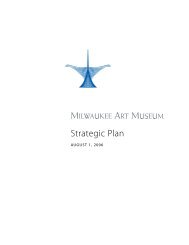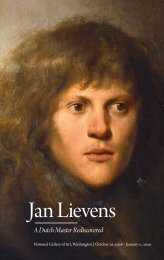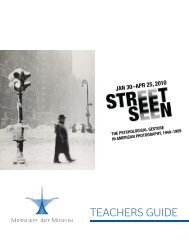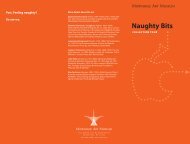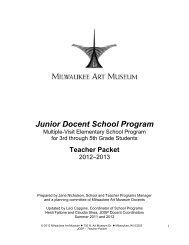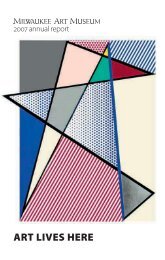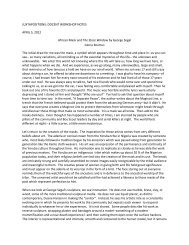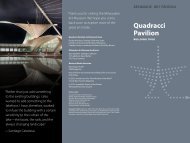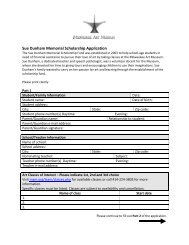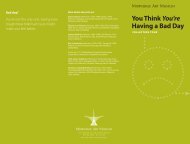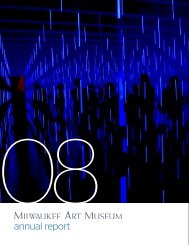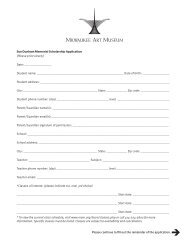Junior Docent School Program - Milwaukee Art Museum
Junior Docent School Program - Milwaukee Art Museum
Junior Docent School Program - Milwaukee Art Museum
Create successful ePaper yourself
Turn your PDF publications into a flip-book with our unique Google optimized e-Paper software.
seldom depicted still. Instead they stretch, move, and gesture. Whether it is a religious<br />
subject, mythological theme, battle, hunting scene, or portrait, Baroque artists gave<br />
drama to the ordinary scenes they depicted in their artwork.<br />
Realism and Naturalism (1830s - 1870 CE)<br />
In the 1800s, the Industrial Revolution caused many social and economic problems.<br />
Jobs were hard to find and working conditions were poor for those people lucky enough<br />
to find employment. There was growing concern on the part of artists and writers about<br />
the plight of ordinary persons at home and at work. The concern was reflected in this<br />
style of art that became popular in the mid-nineteenth century. Realism/Naturalism<br />
implied a desire to depict things accurately and objectively. Although these artists did<br />
paint in a realistic style, the realism they were interested in was a matter of subject<br />
rather than style. <strong>Art</strong>ists limited themselves to facts of the modern world as they<br />
personally experienced them; only what they could see or touch was considered real.<br />
They painted real life: everyday problems, work, and everyone‟s joys and tragedies.<br />
These artists used new ways of handling brushes and paint so that their paintings had<br />
more textures and visual interest. The invention of the camera gave them the possibility<br />
of working from a photograph, an entirely new concept during this time. Realists also<br />
were interested in painting landscapes from a realistic point-of-view, and they were<br />
especially interested in how the land looked during different weather and different times<br />
of the day. Realists‟ desire to paint in the open air and interest in how light affected<br />
one‟s perception of a scene paved the way for Impressionism.<br />
Impressionism (1860s - early 1900s CE)<br />
The European Impressionists began in the tradition of Realism. They favored subjects<br />
that appeared informal and spontaneous. They depicted ordinary people picnicking,<br />
dancing, boating, or on outings in the landscape of northern France. However, it is the<br />
way they painted, and not the subject matter, that is important to Impressionism.<br />
The Impressionists adapted some of the science of optics researched in the nineteenth<br />
century. They understood that when we look at something we see not the object itself,<br />
but light reflected from the object. Our eyes perceive the object as many small spots of<br />
color of varying shades and tones, not as a solid-color shape. To capture this optical<br />
sensation, Impressionists worked on small canvases set up outdoors, painting with<br />
small brushstrokes. They worked quickly, before the sun shifted to a great degree. In<br />
doing so, they were able to produce a feeling of spontaneity rather than of posed studio<br />
effects. They created bright paintings with brilliant colors that almost shimmer in their<br />
intensity and which paved the way for abstract art.<br />
Abstraction (late 1900s - 1940s CE)<br />
Abstraction applies to art that looks as if it contains no recognizable forms from the<br />
physical world. All the artist gives us to focus on are colors, lines, shapes, values,<br />
forms, textures, spaces, and materials. Abstractionists carefully painted and arranged<br />
colors and cleanly outlined geometric shapes. These artists explored new ways to<br />
combine the elements of art (line, shape, color, form, texture, value, and space) in nonobjective<br />
paintings and sculptures to express feelings and distorted shapes and<br />
rearranged parts, reconstructing the subject so it became something totally new and<br />
© 2011 <strong>Milwaukee</strong> <strong>Art</strong> <strong>Museum</strong> 700 N. <strong>Art</strong> <strong>Museum</strong> Dr. <strong>Milwaukee</strong>, WI 53202<br />
JDSP – <strong>Docent</strong> Packet<br />
51



